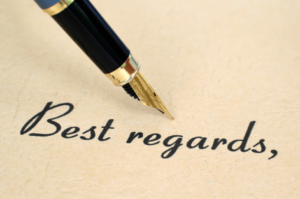Email communication is an essential part of professional and personal interactions. While “Best Regards” is a common closing phrase, using it repeatedly can make your emails sound generic. If you want to add a touch of personality, warmth, or professionalism to your messages, it’s time to explore alternatives.
In this article, we’ll explore 18 other ways to say “Best Regards,” their appropriate usage, and tips to ensure your email closings align with your message tone and audience. Let’s dive in!
Why Should You Switch from “Best Regards”?

While “Best Regards” is polite and professional, it often feels overused and lacks a personal touch. Depending on the context of your email, switching to a different closing can:
- Make your emails stand out
- Strengthen relationships with recipients
- Convey a specific tone (formal, friendly, respectful, or appreciative)
- Show effort and thoughtfulness
Using a varied set of email closings enhances communication and leaves a lasting impression.
18 Alternative Ways to Say “Best Regards”
1. Kind Regards
A slight variation of “Best Regards,” this closing maintains professionalism while adding a softer, more considerate touch. It works well in formal emails and client communications.
Example:
I appreciate your time and assistance. Kind regards, Deven Kumar
You may love this one: 12 Other Ways to Say “Greetings”
2. Warm Regards
If you want to express warmth and friendliness, “Warm Regards” is a great alternative. It’s suitable for semi-formal and casual emails, especially when corresponding with colleagues or clients you have a good relationship with.
Example:
Looking forward to our next meeting. Warm regards, Deven Kumar
3. Sincerely
A classic and professional email sign-off, “Sincerely” is ideal for formal business emails, cover letters, and job applications.
Example:
Thank you for considering my application. Sincerely, Deven kumar
4. Yours Truly
A slightly traditional sign-off, “Yours Truly” conveys respect and is often used in formal correspondence or legal communication.
Example:
I appreciate your feedback. Yours truly, Deven Kumar
5. Respectfully
Use “Respectfully” when addressing senior executives, government officials, or anyone in a higher authority. It demonstrates politeness and professionalism.
Example:
I look forward to your response. Respectfully, Deven Kumar
6. With Appreciation
Perfect for emails where you want to express gratitude, “With Appreciation” conveys genuine thankfulness.
Example:
Thank you for your support on this project. With appreciation, Deven Kumar
7. Thanks in Advance
When requesting something, this closing acknowledges the recipient’s effort and expresses gratitude in advance.
Example:
I appreciate your help with this matter. Thanks in advance, Deven Kumar
8. Many Thanks
This is a friendly yet professional way to express gratitude. It works well in business and personal emails.
Example:
Your insights were invaluable. Many thanks, Deven Kumar
9. Best Wishes
A warm and positive closing, “Best Wishes” suits both professional and personal emails.
Example:
Wishing you success in your new role. Best wishes, Deven Kumar
10. Cheers
A casual and friendly sign-off, “Cheers” is great for informal work emails, especially in creative industries.
Example:
Excited to collaborate on this project. Cheers, Deven Kumar
11. Take Care
If you want to add a caring and personal touch, “Take Care” is an excellent alternative.
Example:
Let me know if you have any questions. Take care, Deven Kumar
12. Have a Great Day
A positive and cheerful closing, this phrase leaves the recipient on a good note.
Example:
Looking forward to working together. Have a great day, Deven Kumar
13. Looking Forward to Your Response
This closing keeps the conversation open-ended and encourages a reply.
Example:
Let me know your thoughts. Looking forward to your response, Deven Kumar
14. Stay Safe
Used particularly in times of uncertainty or crisis, “Stay Safe” adds a personal and caring touch.
Example:
Hope to connect soon. Stay safe, Deven Kumar
15. With Gratitude
A sincere way to show deep appreciation, “With Gratitude” is ideal for emails thanking someone.
Example:
I truly appreciate your guidance. With gratitude, Deven Kumar
16. Cordially
A formal and polished sign-off, “Cordially” is best suited for business emails with an elegant touch.
Example:
I hope this proposal meets your needs. Cordially, Deven Kumar
17. All the Best
A versatile closing that conveys good wishes and positivity, “All the Best” is appropriate for both professional and personal emails.
Example:
Looking forward to your feedback. All the best, Deven Kumar
18. Yours Faithfully
Commonly used in British English, “Yours Faithfully” is appropriate when you don’t know the recipient personally.
Example:
Thank you for your time. Yours faithfully, Deven Kumar
Choosing the Right Email Closing
When selecting an alternative to “Best Regards,” consider:
- The Recipient – Is the email formal or casual?
- The Context – Are you expressing gratitude, requesting something, or maintaining neutrality?
- Your Relationship – Are you addressing a colleague, manager, client, or friend?
- Tone of the Email – Does it require warmth, professionalism, or friendliness?
Examples of When to Use Different Closings
- Formal Business Emails: Sincerely, Yours Truly, Respectfully, Cordially
- Casual Work Emails: Cheers, Take Care, Best Wishes
- Thank-You Emails: With Gratitude, Many Thanks, Thanks in Advance
- Friendly Yet Professional Emails: Kind Regards, Warm Regards, All the Best
Final Thoughts
Switching from “Best Regards” to a more thoughtful closing can enhance your email communication. By tailoring your sign-off to the recipient, context, and purpose, you create a more engaging and memorable interaction.
Try these alternatives in your next email and see how they elevate your message!
Which of these alternatives do you plan to use? Let us know in the comments!
Deven Kumar is the passionate writer and founder behind povforbook.com, a website dedicated to exploring unique perspectives in literature and storytelling. With a deep love for books, language and traveling, Deven aims to inspire readers by sharing insightful reviews, thought-provoking synopses, Guiding tourist by sharing personal experience and engaging content that highlights the power of narrative. When not writing, Deven enjoys connecting with fellow book lovers and traveling lovers and continuously discovering new voices in the literary world.
